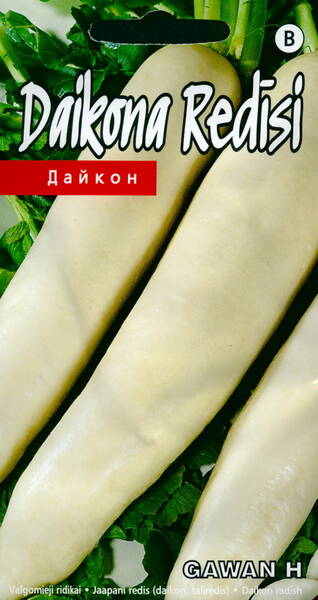Ex Tax: 1.85€
Mid-early variety: grows 75-85 days after sowing (45-50 days after germination). Sow from late June to mid-August.
Root crops are large, grow up to 40 cm long, white, with a delicate taste. Used fresh, suitable for long-term storage.
1.0 g = 60-100 seeds.
The crop is cold-resistant: seeds germinate at +2..+3°C, seedlings tolerate frosts down to -4°C, and mature plants – down to -6°C.
Daikon is a long-day plant: in spring and early summer, bolting occurs faster and root development is slower. In the second half of summer, with shorter daylight hours, favorable conditions are created for the formation of root crops. Although daikon is undemanding and can grow on various types of soil, the best yields are obtained on light, fertile soils with deep groundwater levels.
The shape of the root crop is the main feature determining daikon’s belonging to a certain varietal type. It can be round, cylindrical, conical, elliptical, spindle-shaped, or even snake-shaped. The roots can be completely buried in the soil or protrude above its surface by 1/2 or even 2/3.
SOIL PREPARATION AND SOWING.
Daikon prefers light, well-loosened soils, as its root system can reach up to 60 cm deep. It does not tolerate water stagnation. On light and peat-turf or peat-humus soils, roots are more uniform and smooth. However, a harvest can also be obtained on heavy clay soils.
* Best predecessors: cereals, early potatoes, onions, garlic, cucumbers; unacceptable – all plants of the Cruciferous family.
Depending on the purpose of the root crops, the sowing time is determined. For seed production, it is sown in the first ten days of April; for food use – from the end of June to mid-July. In this case, bolting is usually not observed. However, there are varieties that can be grown in both spring and summer, as they are resistant to premature flower stalk formation.
For a late harvest, planting in August is possible, but when the air temperature drops to +10°C, the plants should be covered with garden agro-fabric or light greenhouses made from it. The harvest of early daikon varieties can be collected after just 40 days, while late varieties take up to 70 days to mature.
Daikon is sown in rows with a spacing of 45 cm between them. A furrow 4–5 cm deep is watered, and then 2–3 seeds are placed every 8–10 cm. The furrows are then covered with loose soil and lightly pressed.
Depending on the conditions (air temperature and humidity), seedlings appear in 3–7 days. When one or two leaves appear, the strongest plant is left in each nest, while the others are removed or transplanted into empty spots where seeds did not germinate.
Daikon plants easily cross-pollinate with radish and turnip, so no flowering plants of these crops should be nearby.
CARE.
Maximum productivity and quality of root crops are achieved only on fertile soils, therefore, one month before sowing, it is advisable to apply organic compost mixed with nitrophoska and ash. During the short growing period, the plantings should be regularly hilled with loose soil and, preferably, every 20 days after sowing, treated with double superphosphate or watered abundantly with a liquid humic fertilizer to stimulate root mass growth.
Daikon should not be grown on sandy or acidic soils. In hot, dry conditions and insufficient irrigation, roots become bitter and coarse. The optimal location for beds is on neutral soils in partial shade, avoiding soil drying during vegetation. Regular watering (5–6 times) is required, using about 350 liters per 10 m² each time. The best watering method is drip irrigation. Excessive moisture should be avoided, as it may cause the development of mucous bacteriosis.
Daikon is demanding regarding optimal spacing, so when 1–2 true leaves appear, the plants are thinned, leaving one strong plant per nest.
DISEASES AND PESTS.
Daikon leaves attract slugs, so a ring of powdered superphosphate should be made around each hole or the soil treated with an approved molluscicide such as “Groza” (scatter 30 g per 10 m² on the surface).
Daikon seedlings are attacked by flea beetles of the Cruciferous family. Sometimes they can completely destroy sprouts within 1–2 days. To prevent this, immediately after sowing, the area should be covered with any non-woven material (lutrasil, agril, spunbond, etc.) and kept covered until the second true leaf appears.
TYPICAL MISTAKES.
Incorrect planting time.
Although daikon is considered an autumn crop, it actually grows well in spring. When sowing in spring, it should be planted as early as possible — “into the mud.” Do not fear frosts: the plants and seeds easily withstand severe temperature drops.
However, if you delay planting, under long-day conditions they will all quickly bolt. In autumn, do not rush to sow — wait until the temperature drops and daylight shortens (less than 12 hours).
High temperatures.
The optimal temperature for growing daikon is +15 to +18 °C. At higher temperatures, roots become coarse and lose flavor. This is another advantage of early planting. If the climate is not mild — hot summers and early frosts in autumn — sow early and mulch the emerging seedlings with straw.
Shading.
The taste and juiciness of roots depend on even watering and temperature, not on shade.
CULTIVATION UNDER COVER.
Early and late harvests of daikon can be obtained in glass or film greenhouses. For this purpose, seeds are sown either in March–April or in August after harvesting heat-loving crops. The sowing scheme is double-row, as in open ground, or triple-row (for economical growers). In the latter case, the average weight of each root crop may decrease by 200–300 g, but the yield can increase up to 10.5 kg/m². Care for plants in greenhouses does not differ from that in open ground: watering, loosening the soil, and weeding are necessary.
HARVESTING AND STORAGE.
The crop is harvested 40–70 days after sowing, depending on the variety’s maturity. Harvest in dry weather, cut the tops, and clean roots from soil. On light soils, daikon can be pulled out by the tops; on heavy soils, to avoid breaking the long roots, dig carefully with a shovel or fork.
Do not over-keep daikon in the soil, otherwise it will lose market quality and may flower. After digging, lay the roots along the bed for a while so that the adhering soil dries and can be easily removed.
Harvested roots are stored in a cellar or refrigerator. The storage period without significant loss of quality is 2–3 months. To prevent wilting, roots are sprinkled with sand or placed in polyethylene bags. Roots obtained from July sowing store best. Storage temperature 0 to +5 °C, relative humidity 80–85 %.
* It should be noted that daikon does not accumulate heavy metal salts, nitrates and toxic compounds in its plant parts, so mineral fertilizers only benefit the crop, being well broken down by biological cells and nourishing the root crop.












